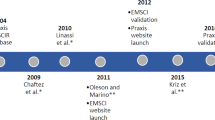Abstract
To capture all pertinent data during spinal cord injury animal experimentation, the authors have designed and implemented a database that is available for use under a public license. Their goals were to record all daily medical care of paraplegic animals, including unexpected complications; to store all injury parameters and/or therapeutic procedures; to track locomotor scores and other measures of functional recovery; to allow planning and management of experiments; and to serve as an externally linkable, SQL-queryable data mining source. Ultimately, the use of databases such as this will allow multiple neurotrauma laboratories to compare animal data through web meta-analysis.
This is a preview of subscription content, access via your institution
Access options
Subscribe to this journal
We are sorry, but there is no personal subscription option available for your country.
Buy this article
- Purchase on Springer Link
- Instant access to full article PDF
Prices may be subject to local taxes which are calculated during checkout






Similar content being viewed by others
References
Metz, G.A., Curt, A., van de Meent, H., Klusman, I., Schwab, M.E. & Dietz, V. Validation of the weight-drop contusion model in rats: a comparative study of human spinal cord injury. J. Neurotrauma 17(1), 1–17 (2000).
Allen, A.R. Surgery of experimental lesion of spinal cord equivalent to crush injury of fracture dislocation of spinal column. A preliminary report. JAMA 57, 878–880 (1911).
Kwo, S., Young, W. & Decrescito, V. Spinal cord sodium, potassium, calcium, and water concentration changes in rats after graded contusion injury. J. Neurotrauma 6(1), 13–24 (1989).
Young, W. The Spinal Cord Injury Impactor (2003). http://carecure.rutgers.edu/ftp/IMPACTOR03a.pdf.
Gruner, J.A. A monitored contusion model of spinal cord injury in the rat. J. Neurotrauma 9(2), 123–126 (1992).
Basso, D.M., Beattie, M.S. & Bresnahan, J.C. A sensitive and reliable locomotor rating scale for open field testing in rats. J. Neurotrauma 12(1), 1–21 (1995).
Basso, D.M. et al. MASCIS evaluation of open field locomotor scores: effects of experience and teamwork on reliability. Multicenter Animal Spinal Cord Injury Study. J. Neurotrauma 13(7), 343–359 (1996).
Young, W., Decrescito, V., Flamm, E.S., Blight, A.R. & Gruner, J.A. Pharmacological therapy of acute spinal cord injury: studies of high dose methylprednisolone and naloxone. Clin. Neurosurg. 34, 675–697 (1988).
Beattie, M.S. et al. Endogenous repair after spinal cord contusion injuries in the rat. Exp. Neurol. 148(2), 453–463 (1997).
Bracken, M.B. et al. Administration of methylprednisolone for 24 or 48 hours or tirilazad mesylate for 48 hours in the treatment of acute spinal cord injury. Results of the Third National Acute Spinal Cord Injury Randomized Controlled Trial. National Acute Spinal Cord Injury Study. JAMA 277(20), 1597–1604 (1997).
Scheff, S.W., Saucier, D.A. & Cain, M.E. A statistical method for analyzing rating scale data: the BBB locomotor score. J. Neurotrauma 19(10), 1251–1260 (2002).
Mills, C.D., Johnson, K.M. & Hulsebosch, C.E. Group I metabotropic glutamate receptors in spinal cord injury: roles in neuroprotection and the development of chronic central pain. J. Neurotrauma 19(1), 23–42 (2002).
Chesler, M., Young, W., Hassan, A.Z., Sakatani, K. & Moriya, T. Elevation and clearance of extracellular K+ following graded contusion of the rat spinal cord. Exp. Neurol. 125(1), 93–98 (1994).
Carmel, J.B. et al. Gene expression profiling of acute spinal cord injury reveals spreading inflammatory signals and neuron loss. Physiol. Genomics 7(2), 201–213 (2001).
Di Giovanni, S., Knoblach, S.M., Brandoli, C., Aden, S.A., Hoffman, E.P. & Faden, A.I. Gene profiling in spinal cord injury shows role of cell cycle in neuronal death. Ann. Neurol. 53(4), 454–468 (2003).
McGuckin, R.H. & Stiroh, K.J. Computers can accelerate productivity growth. Issues Sci. Technol. 14(4), 41–48 (1998).
Acknowledgements
We thank Wise Young for many detailed discussions and for inspiring our work. The Keck Center animal care staff (Hock Ng, Jeffrey Massone, Ryan Kirchoff, and Sean O'Leary) were instrumental in testing and development of SCI-Base. Gregory Voronin contributed to early versions of SCI-Base. The work received support from the New Jersey Spinal Cord Research Commission.
Author information
Authors and Affiliations
Corresponding author
Rights and permissions
About this article
Cite this article
Weeks, J., Hart, R. SCI-Base: An Open-Source Spinal Cord Injury Animal Experimentation Database. Lab Anim 33, 35–41 (2004). https://doi.org/10.1038/laban0304-35
Received:
Accepted:
Issue Date:
DOI: https://doi.org/10.1038/laban0304-35
This article is cited by
-
Stem Cells from Human Exfoliated Deciduous Teeth Modulate Early Astrocyte Response after Spinal Cord Contusion
Molecular Neurobiology (2019)


